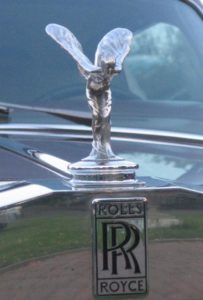Answer:
Because, we like it, and, sometimes it has a functional purpose.

Lots of stuff goes out of use but stays in fashion. There is a historical reason for this hood ornament[1], but, these days, the car would be perfectly functional without it. It just wouldn’t be a Rolls Royce. It’s sort of like the engine sound of a Ferrari. It doesn’t need to make that unique Ferrari sound. Originally, that sound was the natural result of the way the engine was built – the street car had a race car engine – now it’s done with exhaust tuning. It just wouldn’t be a Ferrari if it sounded like a Volkswagen Bug[2].
[1] Hood ornaments started as a totally functional item. They were the radiator cap and sometimes even served as the water coolant temperature gauge. But then engines improved, we didn’t need those gauges, or the cap in that location, and the hood ornament went from functional to decorative.
[2] Of course, if you want your WV Bug to sound like a Ferrari and you have a spare $10K, you can do it: http://kreissieg.ocnk.net/
Maybe that’s what Sullivan was talking about in his 1892 article. If the building needs it for its identity – fine – otherwise leave it off. Apparently, he was pissed about the building designs that were being constructed for the 1893 World’s Columbian Exhibition (World’s Fair) in Chicago. The Exhibition was a huge success. He thought it would set back architectural design in the USA for fifty years. His essay was one of many at that time in the debate about style. I think architects and designers still get animated about style, but, I try to stay out of it.
One thing about that debate, and similar debates about style when building design became very austere, there wasn’t much mention of function. Unfortunately.
Many ornamental items were and are totally aesthetic with no building-function purpose. Take for example, the crosses carved on these capitals:

They serve no purpose other than what you get out of looking at them. Having said that, they also bring no functional harm. They’re neutral regarding building function. Not positive, not negative.
Many ornamental items, however, have great purpose.
 These cast iron stars, for example, are washers at the ends of large structural bolts that serve to connect the wood frame flooring to the load bearing masonry wall. They help to stiffen the masonry. This could have been done with an embedded hook, but, apparently, the builder thought the bolt looked cooler or maybe he didn’t have any hooks available at the time. The builder expressed the structure in the façade of the building. Today, we see this sort of expression of structure in Santiago Calatrava designs – of course, he’s got a Ph.D. in engineering.
These cast iron stars, for example, are washers at the ends of large structural bolts that serve to connect the wood frame flooring to the load bearing masonry wall. They help to stiffen the masonry. This could have been done with an embedded hook, but, apparently, the builder thought the bolt looked cooler or maybe he didn’t have any hooks available at the time. The builder expressed the structure in the façade of the building. Today, we see this sort of expression of structure in Santiago Calatrava designs – of course, he’s got a Ph.D. in engineering.
Gargoyles: great purpose. They serve to direct water away from the building and thereby help prevent damage from freeze-thaw, efflorescence and organic growth. Today’s downspouts are just boring gargoyles.


And, here’s what happens when you skip the gargoyle, mold on the stone:

Cornice at the tops of buildings: Awesome. Try this experiment on a rainy day: First, go outside with a huge umbrella, then, go back inside, get the tiniest possible umbrella and go back outside. When did you get more wet? With the tiny umbrella, of course.




We shouldn’t send our buildings out into the rain with tiny umbrellas. We can do it today because we have some fantastic building materials, but, it’s really taunting Mother Nature. No, or very little roof overhang (or cornice) leads to wet walls. This should be obvious to anyone who has experienced rain, but, scholars and researchers have even studied this[1]. Yup, fewer wet wall problems with bigger overhangs. Perhaps architects who don’t like ornament should be forced to only use tiny umbrellas to help them always remember that larger overhangs prevent water problems.
[1] Straube, J.F., Moisture Control and Enclosure Wall Systems. Ph.D. Thesis, Civil Engineering Department, Universy of Waterloo, April, 1998.
Same for window and door openings: put a roof over them and you’re less likely to have water problems at those openings. Again, we have great materials today – tape that really sticks to everything, liquid applied waterproofing, caulks that last 50 years, plenty of available sheet metal, etc. – but that wasn’t always the case. It used to be that a window was nothing but a hole through the masonry, a wood frame and some wavy glass. Period. That sort of opening needs all the extra help it can get, and that help sometimes looked like this:

This is way more ornamental than Richardson would have agreed with and Walter Gropius’s glasses would probably steam up if he had to do this on one of his designs, but, these are fantastically functional details. First, the exterior sill has a wildly steep pitch. GREAT, no water or snow will stay there and sneakily get into the wood of the window or even into the building. Second, take a close look at the carved detail at the head and jambs, it’s a perfectly elegant drip cut. The only way water can get to that window is if there’s a driving rain. BRILLIANT!
That window opening help can also look like this:
 or this
or this 
Every one of those mini roofs over the window openings serves to either direct water around and past the opening or off the building surface allowing it to fall harmlessly to the ground. Same for the pediment over the front entry – it sends the water somewhere else (oh, and gives you a nice place to do fancy carvings). We could use more of this sort of thing. Unfortunately, we seem to be getting more of the opposite these days:


Zero protection except for the quality of the sticky stuff used between the window frame and the cladding. This can be done, but, leaves no room for error and is prone to problems that arise from natural decay. Of course, what are the chances there won’t be any errors on a construction site? What are the chances that pigs will fly?
Interior details are like exterior details in that some are purely decorative, but many serve a functional purpose. Most interior trim serves to cover up transitions between materials. Door casing, for example, serves to cover up the ugly joint between the material in the field of the wall and the frame of the door. We can do this without that casing, however, it’s much more difficult and, therefore, much more expensive. Contrary to popular belief, elimination of interior trim makes construction more expensive, not less expensive. Zero trim requires perfection of both material and installation. Perfection is expensive.
I have never liked drywall corner bead. It gets dented, the paint always chips, blah, blah, blah, I don’t like it. So, when I built my house I didn’t use it. I trimmed every outside corner with wood. Of course, I didn’t invent this, and protecting outside corners from damage is a legitimate reason to incorporate ornament. It’s sort of like using stone quoins on the exterior of buildings – it helps reduce damage at the corners and adds some life to the building.


Unfortunately, some ornament has negative impact, and not just because it doesn’t look good.

This is a photo of the Aqua Tower in Chicago. I consider those wavy ribs to be ornament. Quoting the designers “the tower was imagined as a vertical landscape made up of hills, valleys and pools.[1]” That’s cool! Unfortunately, in the winter, they really do make the building cool. Here’s what they should remind you of[2]:
[1] http://studiogang.com/project/aqua-tower
[2] This Aqua Tower stuff was originally brought to my attention by Dr. Joe Lstiburek of Building Science Corporation and he’s the person I first saw make the comparison between the Aqua Tower and a convector and a motorcycle engine. I liked it so much that I’ve been repeating it as if it were my story ever since.

Let me make that reminder a little more obvious:


The building is a giant heat exchanger. The principals at Studio Gang can’t build enough Passive Houses in their lifetime to make up for the energy that the Aqua Tower loses through those extended floor slabs. Air-cooled motorcycle engines are designed with this exact same ribbed feature just to help the hot engine cool down. You know it’s cold and windy in Chicago in the winter, right? That’s an eighty-seven story air cooled engine. That’s ornament gone bad.
That’s about it for ornament. Good luck with that hot tub cover question.
Foster
J. Foster Lyons, MS, Assoc. AIA
ARCHITECTURE | INTERIORS | MASTER PLANNING
170 MASON STREET | GREENWICH, CONNECTICUT 06830
203 489 3800 x109 | Cell: 203-969-5224 | HILTONARCHITECTS.COM
Footnotes
2 Hood ornaments started as a totally functional item. They were the radiator cap and sometimes even served as the water coolant temperature gauge. But then engines improved, we didn’t need those gauges, or the cap in that location, and the hood ornament went from functional to decorative.

3 Of course, if you want your WV Bug to sound like a Ferrari and you have a spare $10K, you can do it: http://kreissieg.ocnk.net/
4 Straube, J.F., Moisture Control and Enclosure Wall Systems. Ph.D. Thesis, Civil Engineering Department, Universy of Waterloo, April, 1998.
5 http://studiogang.com/project/aqua-tower
6 This Aqua Tower stuff was originally brought to my attention by Dr. Joe Lstiburek of Building Science Corporation and he’s the person I first saw make the comparison between the Aqua Tower and a convector and a motorcycle engine. I liked it so much that I’ve been repeating it as if it were my story ever since.
